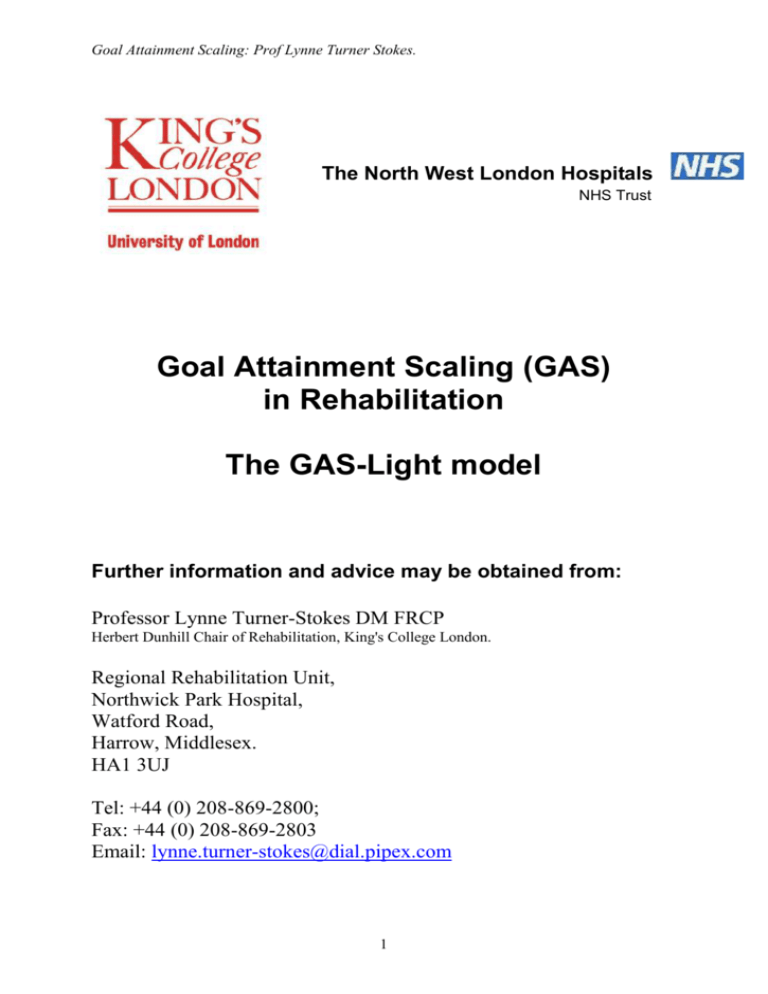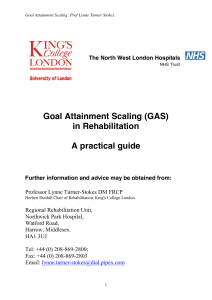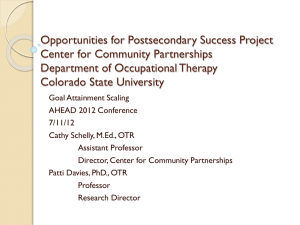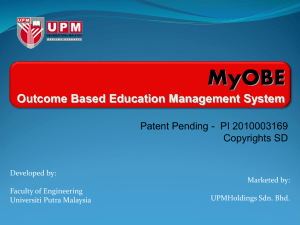The GAS light model - King`s College London
advertisement

Goal Attainment Scaling: Prof Lynne Turner Stokes. The North West London Hospitals NHS Trust Goal Attainment Scaling (GAS) in Rehabilitation The GAS-Light model Further information and advice may be obtained from: Professor Lynne Turner-Stokes DM FRCP Herbert Dunhill Chair of Rehabilitation, King's College London. Regional Rehabilitation Unit, Northwick Park Hospital, Watford Road, Harrow, Middlesex. HA1 3UJ Tel: +44 (0) 208-869-2800; Fax: +44 (0) 208-869-2803 Email: lynne.turner-stokes@dial.pipex.com 1 Goal Attainment Scaling: Prof Lynne Turner Stokes. Background Measuring effectiveness of brain injury rehabilitation poses major problems due to the heterogeneity of patients’ deficits and desired outcomes. Goal-setting has become a routine part of rehabilitation and many multi-disciplinary approaches to clinical care. There is substantial literature which demonstrates its usefulness, both as part of the communication and decision-making process, and as a personcentred outcome measure for rehabilitation (1) Clinicians are increasingly used to measuring outcome as part of routine practice, using a range of standardised measures, but there are some key challenges to address: 1. Although standard measures provide a useful yardstick for comparison, they mostly do not provide us the key thing that we want to know as a clinician - which is ‘did we achieve what we intended to achieve for this patient’? 2. Patients are highly diverse and it is difficult to find a single measure to capture individual aims for treatment – most standardised measures have ‘floor and ceiling’ effects and may not be sensitive enough to capture changes that are important to the individual. 3. Comprehensive measures that might caputure this nuance are usually cumbersome and too time-consuming to use in routine practice. Goal attainment scaling is a technique that captures the extent to which individual goals for treatment were achieved. Measurement of outcome through GAS was first introduced in the 1960s by Kirusek and Sherman (2) for assessing outcomes in mental health settings. Since then it has been modified and applied in many other areas, including the management of spasticity - by Ashford and Turner Stokes(3) GAS offers a number of potential advantages as an outcome measure for rehabilitation. As goal-setting is already a part of routine clinical practice in many centres, it builds on this already established process to encourage: communication and collaboration and between the multi-disciplinary team members as they meet together for goal-setting and scoring patient involvement - there is emerging evidence that goals are more likely to be achieved if patients are involved in setting them. Moreover, there is also evidence that GAS has positive therapeutic value in encouraging the patients to reach their goals(5) In particular, the more formalised process of ‘a priori’ goal setting and defining and agreeing expected levels of achievement with the patient and their family supports the sharing of information at an early stage of rehabilitation and the negotiation of realistic goals. As an outcome measure, there is growing evidence for the sensitivity of GAS over standard measures(8, 9). It potentially avoids some of the problems of standardised measures including: Floor and ceiling effects Lack of sensitivity – particularly of global measures, where individuals make change in one or two important items but this change is lost in the overall scores, where a large number of irrelevant items do not change. GAS is conceptually different from standardised outcome measures, - it is not an outcome measure per se, but a measure of the achievement of intention. Being focused on the specific goals for that individual, it does not provide any absolute value It is therefore necessary to collect standardised measures alongside for the purpose of comparison of different populations, programmes and practices. 2 Goal Attainment Scaling: Prof Lynne Turner Stokes. What is GAS and how is it rated? GAS is a method of scoring the extent to which patient’s individual goals are achieved in the course of intervention. The most important step in GAS is the setting of clearly defined priority goals for treatment that are agreed between the individual and their treating team before starting treatment. Goals should be SMART ( specific, measureable, achievable, realistic, and timed) so that it is the extent of achievement can be accurately rated. At the point of evaluation, GAS is rated on a 5-point scale, ( -2 to +2) with the degree of attainment captured for each goal area: If the patient achieves the expected level, they score 0. If they achieve a more than expected outcome this is scored at: +1 (a little more) or +2 (a lot more) If they achieve a less than expected outcome this is scored at: -1 (a little less) or -2 (a lot less) Goals may be weighted to take account of the relative importance of the goal to the individual, and/or the anticipated difficulty of achieving it. Normally 2-4 goals are identified, which are incorporated into the single composite GAS T- score, which provides an overall rating or the achievement of goals for that patients across all the goal areas. Problems with GAS for use in routine clinical practice A number of problems have arisen with the application GAS as originally described by Kiresuk and Sherman when used in routine clinical practice: GAS provides a flexible and responsive method of evaluating outcomes in complex interventions, but clinicians have reported a number of problems that have limit its uptake as an outcome measure for routine clinical practice: 1. According to the original GAS method, descriptions of achievement should be pre-defined for each of the five outcome score levels (-2, -1, 0, +1 and +2) using a ‘follow-up guide. This is very time-consuming, when ultimately only one level will be used. 2. Clinicians are confused by the various different numerical scoring methods reported in the literature. 3. They generally dislike applying negative scores which may be discouraging to patients, and are put off by the complex formula. This ‘GAS-light’ model has been devised to help clinicians to build GAS into their clinical thinking so that GAS is not a separate outcome measurement exercise but an integral part of the decision-making and review process. Key differences between the GAS-Light and the original method are: 1. The only predefined scoring level is that for the zero score (ie a clear description of the intended level of achievement) SMARTly set and fully documented - all other levels are rated retrospectively 2. The patient and treating team are both involved in both goal setting and evaluation 3. Goal rating is done using a 6-point verbal score in the clinic setting (which is later translated into numerical scores to derive the T-score) The GAS-light approach is described here, taking the example of management of spasticity using botulinum toxin ± therapy (BoNT±T) in the context of routine practice. 3 Goal Attainment Scaling: Prof Lynne Turner Stokes. The GAS light model: Goal setting is an integral part of clinical decision-making in rehabilitation. There are 6 key steps: Intervention Identify Presenting problems Patient Are they amenable to treatment? With what Intervention? Identify broad goal areas Are they worthwhile? Define SMART goals 1 primary 2-3 secondary Goals Evaluate goal achievement GAS Six key steps in decision-making and records needed to inform GAS-light Key steps Clinical decision-making 1. What are the pt’s principal presenting problems? Which, if any, are amenable to treatment with BoNT+T? 2. What do you expect to be able to achieve with BoNT±T? Is this likely to be worthwhile? a) to the patient b) value for money Will you offer treatment? If not, can use GAS 5-point scale to negotiate realistic outcome for key goal areas 3. Is the team and the pt/family agreed on the expected outcome? Record Key problem areas to address: Pain Passive function (caring for limb) Active function Mobility Involuntary movement Impairment (eg range of movement)) Other: If so, broadly define: Primary goal for treatment Secondary goals (limit to 2-3 max) SMARTen goals as reasonably possible: Relate to a specific function and define expected level of achievement* by intended date (usually 3-4 mths) Goal weighting** is optional, but may be useful for qualitative interpretation 4. How will outcome be assessed? Decide which, if any, outcome measures to use. 5. Plan treatment Decide what muscles to inject Make arrangements for therapy and follow-up review Have the goals been achieved? What, if any, further treatment is necessary? 6. Review Baseline values of chosen measures eg Baseline GAS scores for each goal spasticity – Modified Ashworth Scale goal-related parameters* Record procedure: muscles injected, agent and doses use of EMG/stimulation Record level of achievement for each goal Enter in software to derive GAS T score *It is often helpful to use tools such as numeric or visual analogue scales to record levels of pain or ease of caring and to use these for goal setting eg to reduce from a reported pain level of 7/10 to 4/10 ** Importance of goal to the patient (low, medium high) and/or goal difficulty as perceived by team (low, medium high) may be recorded if desired, but mkes little difference to the quantitative evaluation of GAS. 4 Goal Attainment Scaling: Prof Lynne Turner Stokes. Recording GAS without numbers Clinicians often think in terms of change from baseline. A problem with the 5-point GAS score is that it does not allow ‘partial achievement’ of a goal to be recorded of the baseline score was -1. On the other hand if all baseline scores are recorded at -2, this does not allow for worsening. The following algorithm allows clinicians to record goal attainment without reference to the numeric scores, and so avoids the perceived negative connotations of zero and minus scores. A number of scoring systems are currently being explored, including a -3 and a -0.5 option. In the meantime, we propose that clinicians should use a 6-point verbal scale which covers all eventualities and can be computed in any of the models, providing the baseline score is known. The GAS-light verbal scoring system is shown below: Computerisation At Baseline At Outcome: With respect to this goal do they have? Yes Was the goal achieved? No Some function No function A lot more +2 +2 A little more +1 +1 As expected 0 0 Partially achieved (-1) -1 No change -1 -2 Got worse -2 (as bad as they could be) -1 -2 Prof Lynne Turner-Stokes DM FRCP Director Regional Rehabilitation Unit, Northwick Park Hospital and King’s College London School of Medicine. References 1. Hurn J, Kneebone I, Cropley M. Goal setting as an outcome measure: A systematic review. Clinical Rehabilitation 2006;20(9):756-72. 2. Kiresuk T, Sherman R. Goal attainment scaling: a general method of evaluating comprehensive mental health programmes. Community Mental Health Journal 1968;4:443-453. 3. Ashford S, Turner-Stokes L. Goal attainment for spasticity management using botulinum toxin. Physiotherapy Research International 2006;11(1):24-34. 5 Goal Attainment Scaling: Prof Lynne Turner Stokes. Goal Attainment Scaling (GAS) Record Sheet Patient Name:………………………… Age……… Hospital No:…………………………………………… Discharge date:……………………………………… Keyworker:……………………………………………. Patient stated goal 1. SMART goal Imp Diff Baseline Achieved 0 0 1 1 Some function 2 2 3 3 None (as bad as can be) Yes Variance (Describe achievement if differs from expected and give reasons) Much better A little better As expected No Partially achieved Same as baseline Worse 2. 0 0 1 1 2 2 3 3 Some function None (as bad as can be) Yes Much better A little better As expected No Partially achieved Same as baseline Worse 3. 0 0 1 1 2 2 3 3 Some function None (as bad as can be) Yes Much better A little better As expected No Partially achieved Same as baseline Worse 6 Goal Attainment Scaling: Prof Lynne Turner Stokes. Goal Attainment Scaling (GAS) Record Sheet continued Patient stated goal SMART goal 4. Imp Diff Baseline Achieved 0 0 1 1 Some function 2 2 3 3 None (as bad as can be) Yes Variance (Describe achievement if differs from expected and give reasons) Much better A little better As expected No Partially achieved Same as baseline Worse 5. 0 0 1 1 2 2 3 3 Some function None (as bad as can be) Yes Much better A little better As expected No Partially achieved Same as baseline Worse 6. 0 0 1 1 2 2 3 3 Some function None (as bad as can be) Yes Much better A little better As expected No Partially achieved Same as baseline Worse Summary Baseline GAS T-score: Achieved GAS T-score Change in GAS T Score 7








